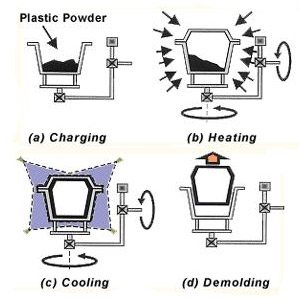What is Rotational Moulding and Benefits
The rotomoulding process is used extensively for the manufacture hollow plastic products. Rotational moulding has the advantage in terms of relatively low levels of residual stresses in the manufacturing process and hence relatively inexpensive moulds.
Rotational moulding also can be ideal for the production of large products such as tanks and bins (> 2m^3) that need to be hollow and can be made in one piece.
Rotational moulding is best known for the manufacture of tanks, but it can also be used to make complex medical products, toys, leisure craft, and highly aesthetic point-of-sale products.
The rotational moulding of plastics materials into products is relatively straight forward. The manufacturing method entails the of introduction of a quantity of plastic raw material in a powder form into a hollow mould. The mould is then rotated around two axes whilst it is heated. The rotation is at low speeds. Once the raw material or plastic is heated in the enclosed mould it adheres to the mould surface in what is called a monolithic layer. To ensure the desired mould shape is maintained the rotation of the mould continues throughout cooling process. When the plastic cool and is adequately stiff, the product is ready for the removal from the mould. In a factory situation, the mould is reloaded and the process is recommenced.
The Process of Rotational Moulding
The basic steps of (a) mould charging, (b) mould heating, (c) mould cooling, and (d) demoulding or part ejection are shown in the figure below.
Benefits of Rotational Moulding
Look around and see all the plastic parts you see in use every day: car components, drink bottles, bags, even the computer you’re currently working on. Plastic technology has advanced dramatically in the past few decades, creating materials that have the following benefits:
· Corrosion resistance
Simply put, plastic cannot rust. Even stainless steel products are susceptible to rust in welded spots.
· Chemical resistance
Plastic can withstand various chemical components, making it a perfect solution for tanks intermediate bulk containers and other containers.
· Durability
Plastic parts are extremely impact resistant and do not dent. Parts can also incorporate metal inserts in high-stress areas.
· Economical
It takes less fuel to operate equipment with plastic parts because plastic is lighter weight than metal. Plastic is typically less expensive than metal. And because rotomoulding easily allows for one-piece construction, assembly times – and therefore assembly costs – are reduced.
· Aesthetics
With rotomoulding, a wide range of colours is available. Because the colour is solid throughout the piece, there’s no unsightly chipping of colour. Rotomoulding also gives you the option of including a colour logo right on the moulded piece, which means your logo cannot peel or flake away. And because rotomoulding allows greater control over the design, you can address the style of the part along with its function.
· Safety
Rotomoulding plastic eliminates sharp corners and burrs and results in a smooth, seamless product. This reduces injury risks for operators. And because rotomoulding allows more control over the design, more ergonomic parts can be created.
· One-part construction
It’s common knowledge that the more components there are in a part, the greater the risk for breakdowns and problems. Using plastic means you can often form one part, rather than welding or bolting together various metal pieces, resulting in greater durability and a longer-lasting product.
Rotational Moulding Advantages
Rotational moulding offers many benefits over other types of plastic moulding such as injection moulding, blow moulding and thermo-forming:
· Greater design flexibility
Rotationally moulded pieces can be designed and manufactured to fit just about any space available. Often parts that are assembled from multiple pieces can be consolidated into one rotomoulded part. That improves design possibilities. And the fewer parts, the fewer chances for part failure.
· Dramatic cost savings
Because there is no interior core to manufacture, tooling for rotational moulding parts is less expensive than tooling for other types of moulding. When compared to most durable metals, plastics are substantially more cost effective.
· Consistent wall thickness
Traditionally, metal components are weakest at the corners – the exact areas where the parts endure the most stress. With injection moulding or blow moulding, it’s difficult to achieve total consistency in wall thickness. With rotomoulding, the constant rotation allows the polyethylene to coat every surface evenly.
· Superior strength
A number of factors contribute to the superior strength of rotomoulded parts: durable new plastics, consistent wall thicknesses, one-part construction and corrosion-resistance.
· Shorter production times
We can usually design the piece, fabricate the mould and start prototype production in 3 to 4 months. This is typically substantially faster than the lead times for most other plastic moulding processes. Getting your finished product to market faster has a lot of advantages.
· Easier to modify
Fabricated moulds are relatively simple, which means that minor changes can be made to an existing mould to accommodate your changing production needs.
· Ability to do small runs
With less expensive tooling, rotomoulding makes it possible to do smaller runs on products. In fact, many of our customers find it economical to do production batches as small as 10 pieces.

